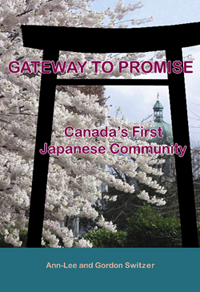Gateway to Promise: Canada’s First Japanese Community
Review By Masako Fukawa, Stanley Fukawa
November 4, 2013
BC Studies no. 180 Winter 2013-2014 | p. 180-182

The authors, Ann-Lee Switzer and Gordon Switzer are both historians and writers with an interest in the Japanese Canadian experience. Gateway to Promise: Canada’s First Japanese Community is a rich history of the Japanese in Victoria before the war. With their expulsion in 1942, their history was forgotten, but has now been revived and can be savoured with the publication of this book.
Excellent general histories of the Japanese in Canada have been written by Ken Adachi, Roy Ito, and Toyo Takata, and studies are available for Chemainus, Cumberland, Mission, Vancouver’s Powell Street, and elsewhere, but this is the first comprehensive history of the Japanese in Victoria, which predated Vancouver as the main gateway to Asia. The Switzers left no stone unturned. They interviewed former residents, friends, and relatives. They corresponded by post and email, conducted phone interviews, read old newspapers in both English and Japanese, and visited archives, libraries, and individuals in their homes. With numerous documents, anecdotes, and black and white photographs, the Switzers establish their claim that Victoria was Canada’s first Japanese community. This book, a clear and definitive history of the Japanese community in Victoria, is also a pleasure to read.
Unlike Vancouver, Victoria had no “Japan Town.” The Japanese were not concentrated in any particular area but lived in various districts of Greater Victoria. Their occupations included farmer, teahouse owner, merchant, boat builder, and fisherman. Victoria’s Ross Bay Cemetery, where the 150 Japanese pioneers are buried, reflects this integration: unlike cemeteries in Vancouver, Prince Rupert, Nanaimo, Cumberland, and Chemainus, there is no section specifically designated for Japanese graves.
The first section, “History: Japanese in Victoria,” provides an overview of local, provincial, and international events that impacted the Japanese in Victoria. Chapters 8 to 17, “Public Space: The Japanese Influence,” present specific topics such as the non-Japanese residents who befriended the Japanese, the role of the Christian churches, the sports teams, the planting of the cherry trees, and the first shipment of mikan (Japanese oranges) to Canada. Of particular interest is the search for Manzo Nagano as the first Japanese immigrant. Or was he? We also learn that First World War veterans were exempt from evacuation (115), and that Mikuni Point on Saturna Island was named for Victoria entrepreneur, Kisuke Mikuni, who was listed on a voter’s list. The authors do not reveal, however, if the list was for a municipal or provincial election (132).
Powell Street in Vancouver, which boasted Japan Town, was a destination for all things Japanese before the war, and since 1977, it has celebrated annually with the Powell Street Festival. Less known is the fact that the tycoon Shinkichi Tamura, who established the Japan-Canada Trust and Savings Company and the New World Hotel, which is still standing in Vancouver, had his beginnings in Victoria working for Charles Gabriel, a friend of the Japanese. And although Hide Hyodo Shimizu is remembered as the first Japanese Canadian to be hired, in 1926, to teach in a public school in British Columbia, Annie Kiku Nakabayashi graduated from the Victoria Normal School five years earlier and was appointed as a teacher for public school education in the church-run Oriental Home. In 1942, the Oriental Home was closed and its eighteen Japanese children and two women sent to a church boarding home in Assiniboia, Saskatchewan (144). The last section, titled “Private Space: Family Stories,” contains accounts of twenty-one families in detail and an additional eighteen shorter sketches of former residents. None of the 273 pre-war Japanese residents returned to Victoria.
It would have made a storybook ending had the Switzers been able to declare that Victoria-born Toyo Takata, eldest son of the family that built and operated the Japanese teagarden, had decided to return to the city he loved. Takata visited from Toronto at every opportunity before his death in 2002 from his love for his classmates from his Esquimalt schooldays, but not even he moved back. Those who left Victoria unexpectedly in 1942, like Takata, found themselves exposed, in the rest of Canada, to communities that were not as rabidly anti-Japanese as those in the Pacific province. British Columbia politicians almost succeeded in leading the Canadian government to ethnically cleanse the province of all Japanese (“No Japs from the Rockies to the Sea” was the slogan of federal Cabinet Minister Ian Mackenzie). Many who moved to Eastern Canada learned that they did not have to build up individual relationships to overcome an “inferior” racial status. Rather, they were granted a social status more based on their occupational qualifications. Some Japanese vowed never to set foot here again, and died upholding their vow. Some questioned the intelligence of those who returned to British Columbia, where they felt racism continued to keep their people down. The influx of Japanese to Victoria in recent years suggests that times have changed and there is now, in the twenty-first century, less racism to contend with compared to the twentieth century.
The Switzers have written with warmth and humour about everything they uncovered about the Japanese in Victoria, including a recipe for the cake served at the Japanese Tea Garden (200). What is missing in this readable and enjoyable book is an index, which would have been most helpful in locating the many nuggets that the reader might want to retrieve.
Gateway to Promise: Canada’s First Japanese Community
By Ann-Lee and Gordon Switzer
Victoria: Ti-Jean Press, 2012. 396 pp, $29.95 paper
